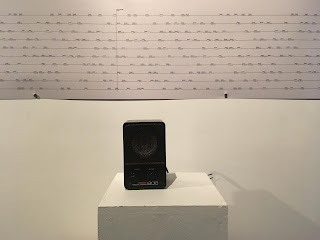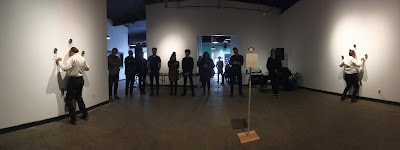| LA CONTAMINATION EST (ici) POSITIVE Exposition sonore. Mai 2018. Eastern Bloc, Montréal Compositions contaminées et contaminantes de : Alexandre Burton, Alexandre St-Onge, André Eric Letourneau, Émilie Payeur, Félix-Antoine Morin, Line Katcho, Marc-alexandre Reinhardt, Nikki Forrest, Patrice Coulombe, Pierre-Yves Martel Bourse du Conseil des Art du Canada, programme Du concept à la réalisation | |
ALEXANDRE ST-ONGE
ANDRÉ ÉRIC LÉTOURNEAU
ÉMILIE PAYEUR
FÉLIX-ANTOINE MORIN
LINE KATCHO
NIKKI FORREST
MARC-ALEXANDRE REINHARDT
PATRICE COULOMBE
PIERRE-YVES MARTEL
Première mondiale ! Une exposition essentiellement sonore.
Déambulation et écoute.
VERNISSAGE, le 2 mai - 19 h à 22 h
EXPOSITION, le 3 et 4 mai - 11 h à 21 h // Le 5 mai - 11 h à 17 h
La Contamination est (ici) Positive est une exposition uniquement d'œuvres sonores. Une machine de contamination a été programmée, elle permet la diffusion de compositions intégrales dans 4 espaces principaux de la galerie . Cette machine permet également l'écoute de la contamination entre ces compositions, contamination qui existe normalement, ici renforcée et positivement augmentée grâce au logiciel développé par Alexandre Burton (Artificiel). Les horaires détaillés des séances d’écoute sont affichés dans les espaces principaux.
La Contamination est (ici) Positive, en chiffres :
Dix compositeur(e)s, 1 programmeur de logiciel, dix compositions de +/-15 mn en 4 pistes stéréo, 4 systèmes de son principaux, 12 enceintes intermédiaires, 1 Machine à Contaminer les Sons
74 heures non stop : 33 heures en galerie, 41 heures en diffusion Internet et dans la galerie, sans public.
Production : Internationale Mimikakiste
Conception de La Machine à Contaminer les Sons (LMCS) : Alexandre Burton, Eric Mattson, Alexandre St-Onge
Digital production numérique : Alexandre Burton







